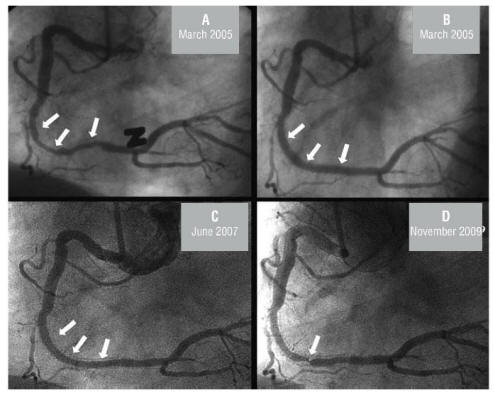Circulation. 2001;104:773.) © 2001 American Heart Association, Inc.
Impact of Smoking on Clinical and Angiographic Restenosis AfterPercutaneous Coronary InterventionAnother Smoker’s Paradox?From the Harvard Clinical Research Institute, Harvard Medical School (D.J.C., M.D., D.E.C., K.K.L.H., R.E.K.); Cardiovascular Division, Beth Israel Deaconess Medical Center (D.J.C., M.D., D.E.C., K.K.L.H.); and Divisions of Cardiology (J.J.P., R.E.K.) and Clinical Biometry (R.E.K.), Brigham and Women’s Hospital, Boston, Mass. Background— Recent studies have suggested that smokers may require less frequent repeated revascularization after percutaneous coronary intervention (PCI) compared with nonsmokers. However, the mechanism of this phenomenon is unknown. Methods and Results— We examined the association betweensmoking and restenosis using pooled data from 8671 patientstreated with PCI in 9 multicenter clinical trials. Clinicalrestenosis was examined in the cohort of 5682 patients who were assigned to clinical follow-up only. Angiographic restenosis was evaluated in the subset of 2989 patients who were assigned to mandatory angiographic restudy. Among those patients assigned to clinical follow-up only, target lesion revascularization (TLR) occurred in 6.6% of smokers and 10.1% of nonsmokers (P<0.001). After adjustment for baseline clinical and angiographic differences,the rate of TLR remained significantly lower in smokers withan adjusted relative risk of 0.69 (95% CI, 0.54 to 0.88). Among the angiographic cohort, there were no differences in the rates of angiographic restenosis or follow-up diameter stenosis in either univariate or multivariate analyses. This dissociation between clinical and angiographic restenosis was explained in part by reduced sensitivity to restenosis on the part of smokers and by the greater reluctance of smokers to seek medical attentiondespite recurrent angina.
Conclusions— In patients undergoing contemporary PCI,cigarette smoking is associated with a lower rate of subsequent TLR without affecting angiographic restenosis. These findings have important implications for the follow-up of smokers after PCI and suggest that cross-study comparisons of rates of clinical restenosis must account for the potential confounding effect of smoking.
|
